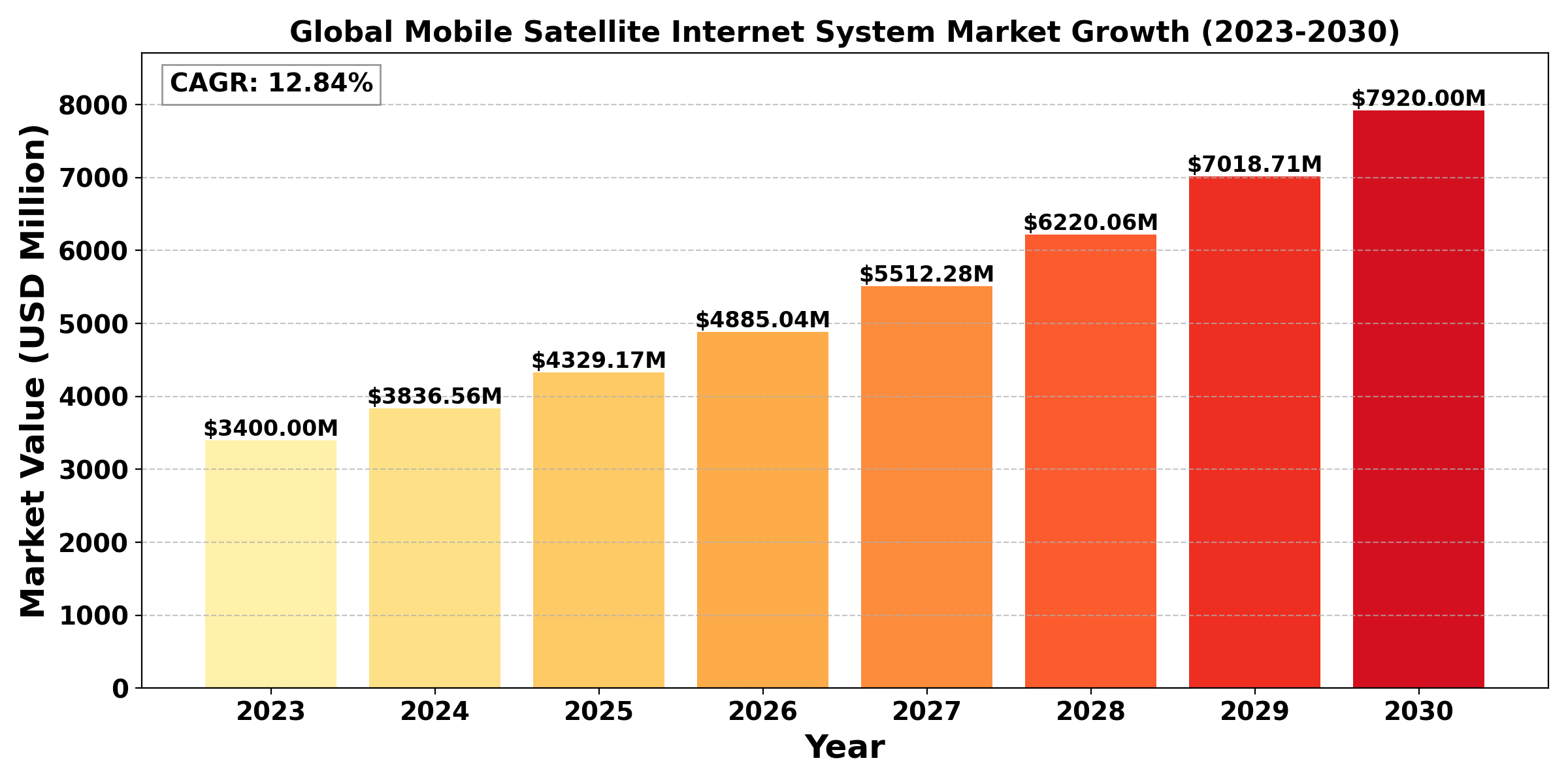Mobile Satellite Internet System Market, Global Outlook and Forecast 2024-2030
The global Mobile Satellite Internet System market was valued at US$ 3.4 billion in 2023 and is projected to reach US$ 7.92 billion by 2030, at a CAGR of 12.84% during the forecast period. The influence of COVID-19 and the Russia-Ukraine War were considered while estimating market sizes.
The global key manufacturers of Mobile Satellite Internet System include Talia, Flyaway, HughesNet, Viasat, Starlink RV, AVL Technologies, Cobham, Harris and Inetvu, etc. in 2023, the global top five players have a share approximately % in terms of revenue.
This report aims to provide a comprehensive presentation of the global market for Mobile Satellite Internet System, with both quantitative and qualitative analysis, to help readers develop business/growth strategies, assess the market competitive situation, analyze their position in the current marketplace, and make informed business decisions regarding Mobile Satellite Internet System. This report contains market size and forecasts of Mobile Satellite Internet System in global, including the following market information:
Mobile Satellite Internet Systems (MSIS) are communication systems that provide internet connectivity via satellite technology for users on the move. This technology is particularly beneficial for users in remote areas, during emergencies, or while traveling, where traditional terrestrial internet infrastructure is unavailable or unreliable.

Technology Overview
- Satellites: MSIS typically use geostationary (GEO) or low Earth orbit (LEO) satellites to provide coverage. GEO satellites are positioned at about 36,000 kilometers above Earth, while LEO satellites operate at lower altitudes, enhancing signal strength and reducing latency.
- Ground Equipment: Users need a satellite dish (antenna), modem, and sometimes a router to connect their devices to the internet. The satellite dish may be fixed or mobile, depending on the use case.
Types of Mobile Satellite Internet Systems
- GEO Systems: These provide widespread coverage but can experience higher latency due to the distance signals must travel. Examples include HughesNet and Viasat.
- LEO Systems: These offer lower latency and can provide faster internet speeds. SpaceX's Starlink and OneWeb are notable examples of LEO satellite constellations.
Applications
- Marine and Aviation: Used for connectivity on ships and aircraft, enabling communication for navigation, safety, and passenger internet access.
- Emergency Response: Deployed in disaster relief scenarios to restore communication where terrestrial networks are damaged.
- Remote Locations: Useful in rural areas, oil rigs, and mining sites where traditional internet infrastructure is lacking.
Advantages
- Global Coverage: Can provide internet access in remote and underserved regions.
- Mobility: Users can stay connected while traveling, including in vehicles, boats, and planes.
- Reliability: Operates independently of terrestrial infrastructure, making it reliable during natural disasters.
Challenges
- Cost: Equipment and subscription fees can be higher compared to terrestrial broadband services.
- Latency: GEO systems tend to have higher latency, affecting real-time applications like video conferencing.
- Weather Interference: Heavy rain or storms can degrade signal quality.
Future Developments
- Ongoing advancements in satellite technology, such as the development of more LEO satellites, aim to improve speed, reduce latency, and enhance global coverage.
- Innovations in ground equipment, including portable satellite terminals, are making it easier for users to connect to satellite internet services.
Mobile Satellite Internet Systems play a crucial role in enhancing connectivity in areas where traditional internet services are unavailable. As technology continues to evolve, these systems are expected to become faster, more affordable, and more widely used in various applications.
We surveyed the Mobile Satellite Internet System companies, and industry experts on this industry, involving the revenue, demand, product type, recent developments and plans, industry trends, drivers, challenges, obstacles, and potential risks.
Total Market by Segment:
By Type
By Application
By Region and Country
- North America
- US
- Canada
- Mexico
- Europe
- Germany
- France
- U.K.
- Italy
- Russia
- Nordic Countries
- Benelux
- Rest of Europe
- Asia
- China
- Japan
- South Korea
- Southeast Asia
- India
- Rest of Asia
- South America
- Brazil
- Argentina
- Rest of South America
- Middle East & Africa
- Turkey
- Israel
- Saudi Arabia
- UAE
- Rest of Middle East & Africa
Competitor Analysis
The report also provides analysis of leading market participants including:
- Key companies Mobile Satellite Internet System revenues in global market, 2019-2024 (estimated), ($ millions)
- Key companies Mobile Satellite Internet System revenues share in global market, 2023 (%)
Key players include:
- Talia
- Flyaway
- HughesNet
- Viasat
- Starlink RV
- AVL Technologies
- Cobham
- Harris
- Inetvu
- Oneweb
- Paradigm
- Thales
- Wideye
- Strigo
Outline of Major Chapters:
Chapter 1: Introduces the definition of Mobile Satellite Internet System, market overview.
Chapter 2: Global Mobile Satellite Internet System market size in revenue.
Chapter 3: Detailed analysis of Mobile Satellite Internet System company competitive landscape, revenue and market share, latest development plan, merger, and acquisition information, etc.
Chapter 4: Provides the analysis of various market segments by type, covering the market size and development potential of each market segment, to help readers find the blue ocean market in different market segments.
Chapter 5: Provides the analysis of various market segments by application, covering the market size and development potential of each market segment, to help readers find the blue ocean market in different downstream markets.
Chapter 6: Sales of Mobile Satellite Internet System in regional level and country level. It provides a quantitative analysis of the market size and development potential of each region and its main countries and introduces the market development, future development prospects, market space of each country in the world.
Chapter 7: Provides profiles of key players, introducing the basic situation of the main companies in the market in detail, including product sales, revenue, price, gross margin, product introduction, recent development, etc.
Chapter 8: The main points and conclusions of the report.
